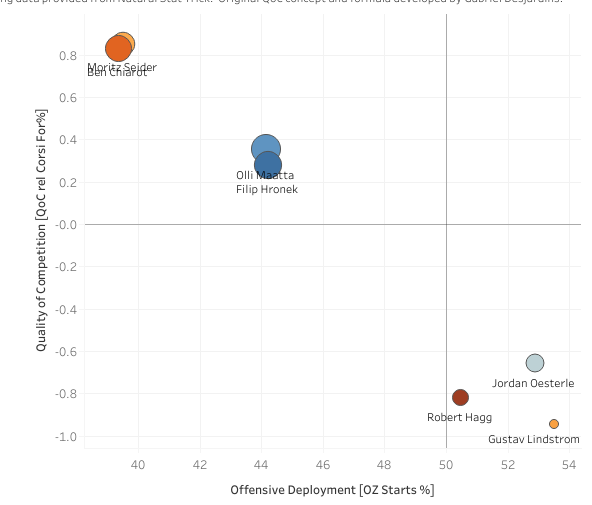The Detroit Red Wings have a big problem. A Moritz Seider sized problem. After entering the NHL in the 2021-22 season and winning the Calder Trophy as the NHL’s top rookie, he is not living up to expectations so far this year. He only has 11 points in 26 games after collecting 50 points in 82 games for his award-winning season.

Head coach Derek Lalonde and his staff have not done enough to assist Seider in breaking out of this sophomore slump he has gotten himself into. I propose three different ways they can address their Seider problem, with various levels of enthusiasm.
Change Seider’s Deployment
The first way that Lalonde can give Seider a boost is by changing the deployment that he and his defence partner Ben Chiarot currently have. They start 40 percent of their zone starts in the offensive zone, and they are facing the most skilled competition from the opposing teams (see below). They are higher vertically than the rest of the defencemen, and further left, indicating a lower amount of offensive zone starts.

If you look at the chart, there is a clear diagonal line between the Seider-Chiarot cluster and the Olli Maatta-Filip Hronek cluster. Both pairings need to move closer to each other: Seider’s pair needs to face slightly less intense competition, along with a few more offensive zone starts. Hronek’s pair could face slightly harder opponents to go with fewer offensive zone starts. That relief of pressure could work wonders for Seider and allow him to have more offensive opportunities.
Call Up Edvinsson & Shake up the NHL Pairings
From the day he was drafted to the day that he retires, Simon Edvinsson will always be compared to Seider. In this case, Edvinsson getting called up could really help out Seider. Edvinsson and Seider can’t be an elite pairing yet, but you can put Edvinsson with another defenceman to free up a new partner for Seider to play with.
Related: Red Wings’ Edvinsson The New Darnell Nurse?
This proposal is simple: call up Edvinsson and put him with Hronek. Put Chiarot on the third pairing and then stick Maatta with Seider. Maatta has a history of great possession numbers and is known for his defensive game. Across the past three seasons, he has outperformed his expected goals (xG) on both ends of the ice; xG is a metric used to determine how likely a given shot is to become a goal based on historical success. Probabilities are generated based on shot location, distance from the net, type of shot, and other variables. Expected goals for (xGF) are the xG rate for the player’s team while that player is on the ice. Expected goals against (xGA) are xGs against that player’s team while they are on the ice.
Over the past three years (including this year), Maatta’s expected goals for (xGF) are 19.82, 45.62, and 16.11 (this year). The actual number of goals for that have gone in with Maatta on the ice are 25, 47, and 24 (this year). More goals have gone in than expected for each of these years, including this season, where Maatta has 16.11 xGF but an actual goals for of 24. Maatta’s xGA this season is 17.59, with only 15 goals have been scored against. Outperforming these metrics proves Maatta’s two-way ability. He can be a stabilizing force that can allow Seider to find his footing.
Change Nothing and Make Game-By-Game Adjustments
This is the least attractive option, yet the most likely. Lalonde has shown us this season that he doesn’t like to shake up the defensive pairings too much. The only pairing that has seen a lot of fluctuation has been the third pairing, which has been a revolving door of Jordan Oesterle, Robert Hagg, Gustav Lindstrom, Jake Walman and a few others.

I’m the least optimistic about this option. The Red Wings are in the second wild card spot with 31 points, which is the last playoff position. We are only 26 games into an 82-game season, so why not change up the pairings? Chiarot’s Corsi for percentage, goals for percentage, and expected goals for and against are all significantly worse than Seider’s (click the advanced stats tab in both links). With some game-by-game adjustments, they can become a better pairing over time, but those changes might not make an immediate impact on the ice for several games.
To help Seider out of his present sophomore slump, the Red Wings can either change Seider’s deployment, call up Edvinsson and pair Maatta with Seider, or leave things as they are and trust that with game-by-game adjustments, the pairing of Chiarot and Seider can get better offensively and defensively.